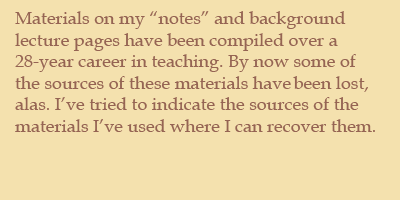
"Romantic Orientalism" — the second term sometimes expanded to "Oriental exoticism" or "Oriental fantasy" — brings together two concepts that continue to be much in dispute among theorists and literary historians. For practical purposes, "Romantic" here refers to the writers (and the ideas and culture they reflect) of the Romantic Period, c. 1792–1830. "Orientalism" refers to the geography and culture of large parts of Asia and North Africa, plus some of what we now think of as Eastern Europe. Above all, from a British point of view, "Orientalism" connotes foreignness or otherness — things decidedly not British — and it sometimes seems as if the "East" signified by "Orient" is not only what is east of Europe and the Mediterranean but everything east of the English Channel. It's as if the exoticism of Othello suddenly became the major cultural fad of Romantic Europe.
In literary history, Romantic Orientalism is the recurrence of recognizable elements of Asian and African place names, historical and legendary people, religions, philosophies, art, architecture, interior decoration, costume, and the like in the writings of the British Romantics. At first glance, Romantic literature may seem to be divided between the natural settings of sheep fields in the southwest of England or the Lake District and the unnatural settings of medieval castles that are, for all their remoteness from present-day reality, always Christian and at least European, if not always British. But a closer look reveals a tiger — decidedly not indigenous to the British Isles — in one of Blake's most famous songs; the founder of the Mongol dynasty in China as well as an Abyssinian "damsel with a dulcimer" in Coleridge's "Kubla Khan"; Eastern plots, characters, and themes in Byron's "Oriental tales," some of which show up later in Don Juan; and an Arab maiden, Safie, as the most liberated character in Mary Shelley's Frankenstein. Orientalism, via the literature and art of the time, was increasingly in the air (as well as the texts) in both London and the British countryside. It was also "all the crack" in decorating (this was the age of Egyptian and Greek furniture) and in clothing--this is the period where Martha Washington's panniers are replaced by Jane Austen's graceful Greek-inspired gowns.
The Orientalism of British Romantic literature has roots in the first decade of the eighteenth century, with the earliest translations of The Arabian Nights into English (from a version in French, 1705–08). The popularity of The Arabian Nights inspired writers to develop a new genre, the Oriental tale, of which Samuel Johnson's History of Rasselas, Prince of Abyssinia (1759) is the best mid-century example. Like Gothic novels and plays, Oriental tales feature exotic settings, supernatural happenings, and deliberate extravagance of event, character, behavior, emotion, and speech. Gothicism and Orientalism do the work of fiction more generally — providing imaginary characters, situations, and stories as alternative to, even as escape from, the reader's everyday reality. But they operate more sensationally than other types of fiction. Pleasurable terror and pleasurable exoticism are kindred experiences, with unreality and strangeness at the root of both. They tie nicely to the increased emphasis on emotions and "the sensibilities" that are the highlights of Romanticism. The classic Oriental poem of the Romantic Period is Coleridge's Kubla Khan (p. 342). Coleridge's note that its composition was interrupted by the pedestrian "person on business from Porlock" (whether true or not) just emphasizes the contrasting exoticism of his poetic fragment. In its use of strange-sounding names, irregular stanzas, and lush sound effects, Coleridge is trying to evoke the "otherness" of this world so far away from the everyday existence of his readers--to evoke an otherworld and take his readers emotionally there.
For many generations, scholars tended to view the Eastern places, characters, and events pervading late-eighteenth- and early-nineteenth-century British literature as little more than stimuli for easy thrills. But this attitude has changed dramatically. Along with its well-studied interests in the inner workings of the mind, connections with nature, and exercise of a transcendental imagination, the Romantic Period in Britain is now recognized as a time of global travel and exploration, accession of colonies all over the world, and development of imperialist ideologies that rationalized the British takeover of distant territories. Now when we read Kubla Khan or Byron's Don Juan, we acknowledge that Coleridge, Byron, and the other Romantics were more aware of British expansionism than we had realized. Such recontextualizing of Romantic Orientalism gives it a decidedly contemporary and political character involving questions of national identity, cultural difference, the morality of imperialist domination, and consequent anxiety and guilt concerning such issues.
Source for a lot of this: http://www.wwnorton.com/nael/romantic/topic_4/welcome.htm
